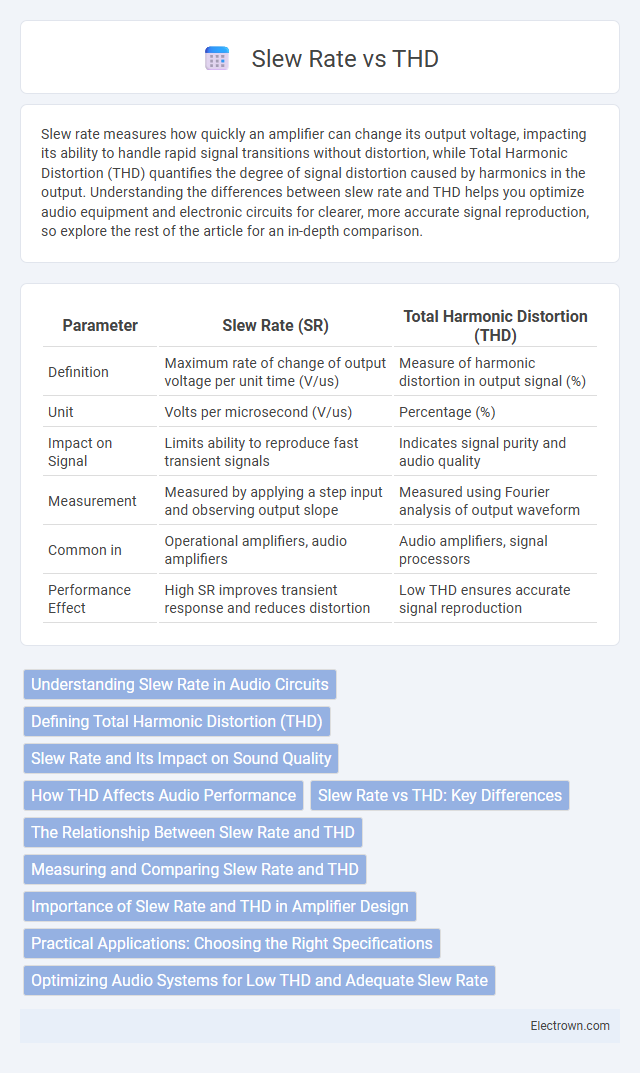Slew rate measures how quickly an amplifier can change its output voltage, impacting its ability to handle rapid signal transitions without distortion, while Total Harmonic Distortion (THD) quantifies the degree of signal distortion caused by harmonics in the output. Understanding the differences between slew rate and THD helps you optimize audio equipment and electronic circuits for clearer, more accurate signal reproduction, so explore the rest of the article for an in-depth comparison.
Table of Comparison
| Parameter | Slew Rate (SR) | Total Harmonic Distortion (THD) |
|---|---|---|
| Definition | Maximum rate of change of output voltage per unit time (V/us) | Measure of harmonic distortion in output signal (%) |
| Unit | Volts per microsecond (V/us) | Percentage (%) |
| Impact on Signal | Limits ability to reproduce fast transient signals | Indicates signal purity and audio quality |
| Measurement | Measured by applying a step input and observing output slope | Measured using Fourier analysis of output waveform |
| Common in | Operational amplifiers, audio amplifiers | Audio amplifiers, signal processors |
| Performance Effect | High SR improves transient response and reduces distortion | Low THD ensures accurate signal reproduction |
Understanding Slew Rate in Audio Circuits
Slew rate in audio circuits defines how quickly an amplifier can respond to rapid changes in the input signal, measured in volts per microsecond (V/us). A low slew rate can cause distortion at high frequencies, contributing to increased Total Harmonic Distortion (THD) and degrading audio fidelity. Ensuring your amplifier's slew rate exceeds the demands of your audio source helps maintain cleaner sound reproduction and reduces unwanted harmonic artifacts.
Defining Total Harmonic Distortion (THD)
Total Harmonic Distortion (THD) quantifies the harmonic content in an electrical signal, representing the ratio of the sum of the powers of all harmonic frequencies to the power of the fundamental frequency. THD is critical in audio and power systems as it affects sound quality and waveform purity. Slew rate limitations in amplifiers can increase THD by causing distortion during rapid signal changes, thereby degrading overall signal fidelity.
Slew Rate and Its Impact on Sound Quality
Slew rate directly affects an amplifier's ability to reproduce rapid signal changes, influencing sound clarity and detail. Insufficient slew rate can cause distortion known as slew rate distortion, degrading Your audio experience by blurring transient sounds and high frequencies. Understanding the relationship between slew rate and Total Harmonic Distortion (THD) is crucial for selecting audio equipment that maintains fidelity and minimizes unwanted artifacts.
How THD Affects Audio Performance
Total Harmonic Distortion (THD) directly impacts audio performance by introducing unwanted harmonic frequencies that distort the original signal, leading to a loss of clarity and fidelity. High THD can cause audio output to sound muddy, harsh, or less detailed, diminishing the listening experience. Managing THD levels ensures your audio system delivers clean, accurate sound reproduction for optimal performance.
Slew Rate vs THD: Key Differences
Slew rate measures the maximum rate of change of an amplifier's output voltage per unit time, directly impacting the ability to faithfully reproduce fast transient signals without distortion. Total Harmonic Distortion (THD) quantifies the level of harmonic distortion present in the output signal, reflecting the amplifier's linearity and fidelity. While a high slew rate reduces distortion caused by rapid signal changes, low THD indicates overall signal purity, making both critical but distinct parameters in audio amplifier performance evaluation.
The Relationship Between Slew Rate and THD
Slew rate significantly impacts Total Harmonic Distortion (THD) in audio amplifiers, as insufficient slew rate limits the circuit's ability to accurately reproduce fast signal changes, leading to increased harmonic distortion. When the slew rate is too low, the output signal cannot follow rapid input variations, resulting in waveform distortion and elevated THD levels. Ensuring your amplifier has a high enough slew rate minimizes THD, delivering cleaner and more precise audio performance.
Measuring and Comparing Slew Rate and THD
Measuring slew rate involves assessing the maximum rate of voltage change per unit time, typically expressed in V/us, while Total Harmonic Distortion (THD) quantifies the percentage of harmonic distortion relative to the fundamental signal in audio equipment. Accurate comparison requires using an oscilloscope to capture slew rate response and a spectrum analyzer or distortion analyzer to measure THD levels under the same operating conditions. Understanding the interaction between slew rate and THD helps optimize your audio system's linearity and signal fidelity.
Importance of Slew Rate and THD in Amplifier Design
Slew rate and total harmonic distortion (THD) critically influence amplifier performance by directly impacting signal fidelity and output clarity. High slew rate ensures rapid voltage changes without distortion, while low THD indicates minimal harmonic artifacts, both essential for maintaining audio precision. Optimizing these parameters enhances dynamic response and reduces signal degradation in amplifier circuits.
Practical Applications: Choosing the Right Specifications
Selecting the appropriate slew rate and total harmonic distortion (THD) specifications is crucial in designing high-fidelity audio amplifiers and precision instrumentation. A higher slew rate ensures accurate signal tracking during rapid voltage changes, minimizing distortion in fast transient signals, while low THD maintains signal purity by reducing harmonic artifacts. Balancing these parameters optimizes performance in applications such as RF communication, medical devices, and professional audio equipment where signal integrity and response speed are paramount.
Optimizing Audio Systems for Low THD and Adequate Slew Rate
Optimizing audio systems requires balancing low Total Harmonic Distortion (THD) with adequate slew rate to ensure accurate signal reproduction and prevent distortion during rapid waveform changes. Low THD maintains signal fidelity by minimizing harmonic artifacts, while sufficient slew rate supports the amplifier's ability to track fast transient signals without slew-induced distortion. Your audio system achieves optimal clarity when these parameters are carefully matched to the intended application and speaker requirements.
slewrate vs thd Infographic

 electrown.com
electrown.com